Emergency Medicine Residents
Three Year Residency Program
We have a vibrant, wellness oriented, close-knit team of 16 residents per class. Our residents hail from all over the country with interests across EM and especially the outdoors. Western Mass offers a wide variety of year round activities to keep you active and well. The beauty of having a larger program is finding folks that have similar interests as you - odds are if you've got a specific interest, we've got a WhatsApp for it.
One way our classes work together to support one another is in their Big/Little Sibling family pairings. These teams act as a built-in support system from the day you start residency (even before). We use this pairing for fun activities at retreat and for year round board review.
Current Residents
PG1

Sophie Barlos, MD
University of Massachusetts
Hey! I'm Sophie. I'm originally from Winchester, MA, and I did my undergraduate degree in neuroscience at McGill University. I was back home for medical school at UMass, where I liked each of my clinical rotations so much that I couldn't decide on which specialty to apply into until the start of fourth year. Ultimately, I felt that the ED captured a little bit of every facet of medicine and was just the place for me!
I chose Baystate because I know I will not only get the patient exposure and education necessary to be a great physician, but also the support to feel balanced and healthy. Though I didn't get a chance to rotate at Baystate, several of my medical school friends were part of the PURCH track at UMass and had their clinical rotations here. They were always gushing about how great everyone at this program is! I could feel the warm and welcoming environment created by this team even through my virtual interview screen, and I felt this would be an amazing place for the next stage of my life. My partner is also very happy to be staying in our home state, and to be moving just down the road from his favorite motorsports racetrack.
Outside of the hospital, you can find me playing soccer, tennis, or ultimate frisbee. In the winter, I often head up to the mountains for some skiing or hiking. I also love diving into a new sci-fi or fantasy book with my book club.
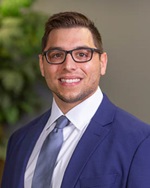
John Choptij, DO
University of New England
Hey everyone, I'm John! I was born and raised in Rocky Hill, CT. I attended CCSU for my undergraduate studies in Biology and Chemistry and afterwards attended medical school in Maine at University of New England College of Osteopathic Medicine.
After medical school, I attended ECHN Manchester Memorial Hospital Family Medicine Residency, where I completed my first residency. I found myself enjoying the life of an acute care physician in the Emergency Department and Intensive Care Units and decided to take the plunge into a second residency in Emergency Medicine!
I am so happy I am attending Baystate for my second residency. It has everything I was looking for in a program to help me become the best Emergency Medicine physician I can be. I had the chance to rotate there during my PGY-3 Family Medicine year and I was blown away by the amount of support I received from the faculty and residents. I truly felt like a member of the team. Not only that, but the acuity of Baystate really drew me in along with the excellent learning experiences that occur on a daily basis in the Emergency Department.
Outside of medicine, I enjoy hiking, snowboarding, lifting heavy weights, baking and giving our puppy, Ellie, plenty of treats.
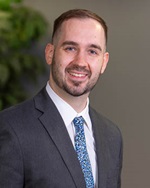
Joe Fabozzi, DO
Lake Erie College
Hi, I’m Joe! I’m originally from Staten Island, NY. I went to undergraduate at Wagner College on Staten Island and majored in Biology with a minor in Chemistry. I have always had a passion to pursue medicine but was undecided as to what field to go into. After spending some time working as a medical scribe, I attended medical school at LECOM in Elmira, NY. After my third-year elective in the Emergency Department, I knew the ED was where I belonged. I grew up in a large Italian and Irish family and am number 5 of 7 children. My family has always been a chaotic basketball family, which ironically made the ED feel like home. Unlike my siblings, my talents on the court never really developed, but thankfully my love of medicine did.
Being a lifelong New Yorker, my fiancée, Nicole, was who initially showed me Western Massachusetts given that her family is from Rhode Island. While that had put Baystate Health on the radar, it was when I spoke to the faculty that I learned what made Baystate special. I am very excited to start this new journey into becoming the best ED doctor I can be, and there is no better feeling than knowing that this program will support me with whatever I need.
In my free time, I enjoy golfing, working out, and playing video games. Back on Staten Island, my family is actively involved in teaching sports to special needs children. Whenever I visit, I try to volunteer as much as possible. My fiancée and I also have an Australian Shepherd named Finley, who is a very active dog. Whether it is a long walk or a short hike, Finley loves to get out and play, which gives us a reason to stay busy. I am always open to new experiences and am frequently referred to as the “yes man.” I love a good laugh and try to keep a positive outlook on life. Life is too short to not enjoy it, and I am blessed and thrilled to begin this next chapter of my life!

Samira Fazli, DO
New York Institute of Technology
Hey y’all, my name is Samira! I grew up in Dallas, Texas, but moved with my family all the way north to Toronto, Ontario when I was a teenager. Though I love Toronto’s culture and summers for many years, I eventually escaped the cold winters and moved back to Texas.
After finishing my undergraduate education at the University of Texas in Arlington, I continued to graduate school at the University of Texas in Dallas, where I completed a Masters in Healthcare Management and an MBA. This is also where I met my wonderful husband! My educational path eventually brought me to NYITCOM in Arkansas State University, where I completed my medical education. I always loved emergency medicine, and chose Baystate for the rich local culture, the wonderful people, and the amazing training program!
When not working hard in the emergency department, you can find me curled up with a book, or in the kitchen trying a new recipe. I also enjoy the warm summer weather, hiking or traveling when possible, or simply spending time with family and friends. I love teaching myself new skills (my most recent ventures have been crocheting and teaching myself to play the piano). I am super excited for the move back to the north, and for the adventure that Springfield will bring for me!

Chirag Ganesa, MD
Loyola University Chicago
Hi everyone- I’m Chirag! I grew up in Shrewsbury, MA, and went to Northeastern University for undergrad to study biochemistry. After graduating, I took a gap year before med school and worked at a biotech company in Boston. I figured if I ever wanted to move back to Massachusetts, I should try living in another state first and that’s how I ended up at Loyola in Chicago for medical school—always still rooting for Boston sports, of course!
During my away rotation at Baystate, I knew this was the right residency for me. The residents and faculty made it feel like home, and seeing the high volume and high acuity patients we treated, gave me confidence that I’d be ready to handle anything after residency.
When I’m not at the hospital, I’m either watching Boston sports (or going to games when I can), walking my French bulldog, re-watching the office, or hunting for new ice cream spots.

Alex Hay, DO
Lake Erie College
Hey y'all! I grew up in Ithaca, NY and then headed out west to CA and UT for school, completing my bachelors in Exercise Sciences. I started to fall in love with the emergency department when I worked in the ED as a tech for many years during undergrad. I continued to explore the western US for a few more years before returning closer to home for medical school at LECOM in Elmira, NY. While going through medical school, I tried to keep an open mind about specialties, but I always felt called back to emergency medicine.
At Baystate, I was impressed with the harm reduction efforts in place to support patients, the acuity and volume of the patients, and the really wonderful, brilliant faculty. I also appreciated some smaller things like having food during didactics, and having an actual Candy Safe in one of the pods for a mid-shift pick-me-up, and plentiful one-on-one mini teaching moments from the attendings on shift. I am also happy that Baystate is in a geographic location that allows me to be close to my partner, Nick, who is an emergency medicine resident in New Hampshire.
In my downtime, you can find me backpacking, climbing outside, roller blading, going on a run, or a bike ride. My partner and I discovered a new obsession with cross country skiing in the north east this past winter. On more mellow days, you can find me crocheting or knitting while cuddling my two cats, taking care of my plants, and listening to audio books.
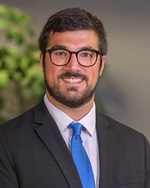
Nick LaMothe, DO
University of New England
Hey, I’m Nick! I’m a big fan of dogs, the great outdoors, and hanging out in my garage working on anything with a motor. I grew up in Torrington, Connecticut and went to Holy Cross for my undergrad where I received a Bachelor’s in Psychology. After that, I wanted to get a taste of living outside New England, so I ventured to Philadelphia and completed a post-bacc at Temple University. As much as I enjoyed Philly, I knew New England was home and found myself in Maine at the University of New England for medical school. While there, I was able to enjoy everything Maine has to offer from spending a day at the beach to camping at Acadia National Park. Outside of school, I’ve also been an EMT for ten years. My interest in emergency medicine stems from my time as an EMT and having the opportunity to provide prehospital care to a diverse population of patients.
During my fourth year of med school, I was fortunate enough to do an away rotation at Baystate. From my first day here, I felt a sense of belonging to the team and found that most everyone shared many of my interests – both in EM and life in general. While I was able to interview with programs that offered what I was looking for in a residency, Baystate really stood out in a number of ways. The camaraderie, passion for teaching, and emphasis on resident wellness really set this program apart and confirmed it as my top choice.
In my spare time, you can usually find me with my girlfriend, a native Vermonter and ER nurse (she knows the life), checking out local live music, farmer’s markets, thrift stores, and new spots to hike with our energetic dogs. I’m so excited to be here at Baystate and for everything that the next few years have in store!

Sarah Petrides, DO
Midwestern University Arizona
Hey guys, I’m Sarah! I grew up in Scottsdale, Arizona but first made the journey to Massachusetts for undergrad at Brandeis University. After that I spent two years earning my MPH from Boston University focusing on Epidemiology and Biostatistics. I moved back to Arizona in 2021 for medical school at Midwestern University but have been trying to get back to New England ever since.
My first introduction to emergency medicine was as a volunteer EMT in college and my rotations in medical school confirmed that the ED was the place for me. I fell in love with Baystate during my away rotation. The personalities of everyone in the department made me feel so at home during my month and I loved the intensity, diversity, and high acuity of the department.
Outside of the hospital you can usually find me in tie dye at a concert, I’m a big fan of all things jam band (the Grateful Dead, Billy Strings, and Goose are some of my favorites) I love to be outdoors camping, hiking, and rock climbing but also enjoy nerdier activities such as reading and a good bar trivia night. Im so excited to spend the next 3 years back in New England!

Jerry Romeo, MD
Drexel University
Hello everyone. My name is Gerardo Romeo, but most people call me Romeo or Jerry. I am originally from Long Island, New York. I attended undergraduate school at Adelphi University and dental school at Stony Brook University. Emergency medicine is a second career for me and I consider myself truly fortunate to have the opportunity to be at Baystate.
I received my medical degree from Drexel University and my MBA from the Zarb school of business at Hofstra University. I have been practicing as an Oral/Maxillofacial and Pediatric cleft/craniofacial surgeon for the past 15 years and I've worked in various roles and institutions spanning from New England to the Midwest. I have a bunch of crazy kids and an incredibly supportive wife, which is why I now get to follow my path and passion into the emergency department.
I like to think of myself as a little old school and little older school, but with new school sensibilities. Music makes me happy and I love all types, but I have a soft spot for 1990s punk rock, and all things Motown records. I love cars and clothes from the 1950s, but all of my favorite movies are from the 1980s. I’m a sucker for seemingly useless information because you never know what could become a golden trivia nugget down the road.
Spending downtime with my family and with friends is where I feel like everything will be OK and a little warm sun on the beach makes it all that much better. I love to play music, soccer, golf, surf, snowboard, and paddle. Cheeseburgers and pizza are my rocket fuel. I am a devoted fan of the New York Jets, which is proof that I don’t give up easily and that even the smallest glimmer of hope can go a long way in giving it all another go tomorrow.

David Schnorbus, MD
Saba University
Howdy! My name is David and I’m from Staten Island, NY. I didn’t spend much time there as my dad worked as a Special Agent for the US State Department. This entailed spending time in Spain, Bulgaria, South Korea and Mexico with my family including my mom, brother and dog. It was a wild journey that lasted about 15 years.
I knew when I was in 6th grade that I wanted to be a physician after dissecting a frog in my science class. For college, I went to Virginia Tech and majored in Biological Sciences. Go Hokies! I completed a Biomedical Sciences certificate as part of the George Squared program. Subsequently, I completed a Masters in Physiology and Biophysics at Georgetown University. During my time completing higher level coursework, I worked various jobs, including as a food label regulatory consultant in Washington DC. Ultimately my path brought me back to NYC where I worked as a scribe for several urgent cares. The pandemic presented a unique circumstance to start medical school and I pursued my education at Saba University.
My decision to come to Baystate was heavily influenced by the culture and people. The interview was a great experience and I thought the camaraderie was unique. After coming for a second look, I could say with complete confidence that the culture was palpable and strong. For me, that was an environment that I wanted to join and felt would contribute best to my continued development as a physician. I love watching and playing sports. I live and die each season with the Mets and Jets. I love dogs and enjoy spending time with family and friends.

Hayley Schnorbus, MD
Saba University
PNW girlie here! Hailing from Vancouver British Columbia, I spent a majority of my formative years as a competitive skier, and as far as representing Canada internationally. During undergrad I studied Biochemistry, and took a sabbatical to drive a camper van around Australia. After my return from vagabonding I switched my education focus to nursing & shortly there after starting working in the emergency department at a level 1 trauma center. Naturally working in the ED I was peer pressured to start competing in triathlons with my emerg colleagues. Fast forward a few years of working in the ED, a few IronMans later & a global pandemic I decided to further advance my education to become a physician.
Baystate was all vibes for me. I knew at the end of the day a majority of the programs I was looking at for residency would provide me the training to be a competent ED doc. Nevertheless, I prioritized who I was with, and where I was training.
Outside of the hospital I love being outside, skiing, running, hiking and playing beach volleyball. Fear not, I do love to lounge, nap and watch sports on the couch.

Nic Sian, DO
University of New England
Hi everyone! My name is Nic and I was born and raised in Westford, MA. In my free time I like to hike, ski, rock climb, and bake. Right out of high-school I knew that I wanted to do emergency medicine, so I got my EMT license and worked on an ambulance. I studied Kinesiology at UMass Amherst and met my lovely fiancée Lara through the EMS team on campus. After I graduated college, I took a gap year and continued to grow my passion for EM by working as a patient care technician at Tufts ED during the COVID pandemic. I then attended UNECOM for medical school where I tried to keep my options open about different career paths, but I couldn't resist the call back to the ED. I found that I loved the fast pace, the teamwork, and the impact I had in my community. I spent my two clinical years of medical school in New Jersey where I was far away from my family and hobbies. During my audition rotation at Baystate I experienced the high acuity, diverse patient population, and emphasis on resident wellbeing. I truly fell in love with the program! I was so excited to hear that I had been accepted to residency at Baystate knowing that I would have everything and everyone I love close by. My fiancée and I are beyond excited to return to our roots.
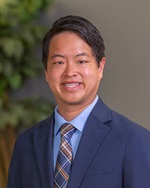
Brandon Skwarto, DO
University of New England
Hi there – I’m Brandon! I was born in Seoul, South Korea but was adopted as a baby so I grew up in Taunton, Massachusetts. I first came to western MA for college, where I completed a dual bachelor’s in Biology and Applied Math at UMass Amherst. In college, I knew I wanted to go into medicine so I got certified as an EMT and a pharmacy technician to better understand our healthcare system.
I was first introduced to Baystate when I worked as the Director of Training for UMass Amherst EMS, coordinating guest lectures and trainings with the EMS division here. After college, I was fortunate enough to get a job here as an ED Assistant and then as an ED Tech. From my first day, I immediately felt welcomed as part of the family – everyone, regardless of role, was always so willing to teach and help me grow.
When looking at residency programs, Baystate checked all my boxes – we have a high volume, high acuity, and diverse patient population but also a team that I know will support me no matter how hard things get.
Outside of work, I love to spend my time exploring food with my partner – whether in our own kitchen or rediscovering some of the great restaurants nearby! After a good meal, you’ll probably find me outside on the hiking trails with an audiobook exploring all the beauty of the Pioneer Valley!
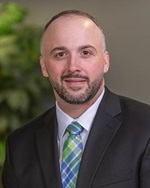
Andrew Spruce, MD
St. Matthew's University
Hi everyone, I am Andrew. I grew up in Bangor, Maine, home of Paul Bunyan (don’t argue with me, Minnesota) and your favorite horror stories. I guess you could say it was a unique experience. I have fond memories of summers in Northern Maine, picking blueberries, befriending lobsters in Bar Harbor, and wrestling the occasional black bear on Mount Katahdin. You know, the way life should be.
As a teenager I began volunteering for a wilderness search and rescue team. I suppose that is where my emergency medicine journey really began. Aside from instilling the cliché emergency physician love for all things outdoors, it sparked my interest in caring for people in need, often on their worst day. I started volunteering as a firefighter and EMT, and received my paramedic license at 19. After years of working as a career firefighter/paramedic in Maine, I moved to Washington, DC, where I spent several years as a helicopter flight paramedic for Children’s National Medical Center and MedStar Health. These were some of the most rewarding experiences of my life.
After years of contemplation, I made the leap into medical school. The work was challenging and gratifying, and I graduated at the top of my class. While I kept an open mind toward all specialties, the pull toward emergency medicine was inescapable. It was this pull towards emergency medicine that drew me to Baystate. I was drawn not only to the high volume and high acuity, but to the values I share with Baystate including empathy, autonomy, and excellence. The supportive environment cultivated by the leadership at Baystate makes me confident that I will thrive during my residency.
I am thrilled to have this opportunity and to return home to New England and to start this new chapter at Baystate!

Ali Stern-Harbutte, DO
Nova Southeastern University
Hi everyone, I’m Ali! I’m a Florida native who's lived all over the Sunshine State. I attended the University of Florida (Go Gators!) for undergrad where I majored in microbiology, and then I made my way to USF for my master’s degree in medical sciences. I stayed in the area and started medical school at NSU’s Tampa Bay Campus, but for the last two years I’ve been living in South Florida, where I’ve been soaking up every bit of the palm trees and sunshine since.
I officially fell in love with emergency medicine during my third year of medical school. Finding a specialty that's fast paced, a little chaotic, and sprinkles in a bit of everything felt like home to me. I first learned about Baystate during my residency search, and it checked every box on my list. After connecting with residents and faculty and learning more about the program, I knew this was where I wanted to start the next chapter of my life (even if it meant learning how to survive real winters).
Outside of medicine, I’m usually on a mission to find the best local coffee shop, dig through a music store, or continue my very serious, important quest to discover the best acai bowl. Exercise and group fitness have always been big parts of my life, and I love exploring new hiking trails or walking paths. I’m also a huge music lover, and while I wasn’t blessed with the ability to play an instrument, I make up for it by going to concerts or seeing local bands. If I’m not out and about, I love cooking at home and experimenting with new recipes. I’m so excited to join the Baystate family, experience all four seasons for the first time, and start this amazing new adventure!

Andrew York, DO
University of New England
Hello! I’m Drew. I was born and raised in Maine, spending my childhood in both the northern and southern parts of the state. After high school, I went to the University of New England for undergrad, completing degrees in Biology and English, and then went back for medical school. Through undergrad and into medical school, I worked at my local ED as a tech. I fell in love with the team-based approach to medicine, as well as seeing a varied amount of pathology and meeting people from different walks of life.
When I was researching residency programs, I knew I wanted to be at a high acuity, high volume Level 1 trauma center with a well-rounded EM curriculum. Baystate was just that, and once I was exposed to their wellness-focused culture, it was a clear winner. On my rotation here, I immediately felt welcomed and part of the team. I knew if I trained here, I could practice anywhere.
I’m excited to be in Western Mass for the next three years for many reasons, including the hiking and running trails, the music and art scene, and the ability to do easy day trips to all parts of New England. Mostly though, I’m excited to help take care of a new patient population and make a bunch of new friends along the way.
PG2

Gabrielle Carroll , MD
UMass Chan Medical School - PURCH Track
Hi everyone, I’m Gabby! I grew up in Mashpee, MA out on Cape Cod. I moved to Western MA for undergrad at UMass Amherst. During undergrad, I studied biology and started working for UMass EMS. I also got my first look at Baystate when I started volunteering in the pediatric ED here! During my last year of undergrad and my gap year I worked on the ambulance in Springfield. I then attended UMass Med, where I was in the PURCH track. In this track, we had a focus on the social determinants of health affecting the Springfield community, and I ended up completing all but one of my rotations at Baystate. I also have been working for the last few years on developing Baystate’s Hospital-Based Violence Intervention Program, Better Tomorrow.
I chose Baystate for a lot of reasons. I love the people, the culture, and the patient population. I have lived in Western MA long enough that now it feels like home, and I don’t want to leave!
Outside of medicine, you can find me doing yoga, learning pottery, hiking, baking and cooking vegan food, and catching up on my favorite true crime podcasts.

Julianna Fazio, MD
Drexel University Medical School
Hey everyone! I’m Julianna. I grew up just outside of Springfield in East Longmeadow, MA. I decided I needed some more sunshine and completed my undergrad in biomedical science at UCF in Orlando, FL. I spent my gap year riding along with a local ambulance service as an EMT before heading to medical school at Drexel in Philadelphia (and I think the hardest part about medical school might’ve been being a Patriots fan in Philly).
I was able to do a rotation at Baystate and immediately knew this was the program for me. The residents were genuinely confident in taking care of the sickest patients and the entire residency had all-around great vibes. I’m most excited to finally come back home and complete residency in the community where I grew up!
Outside of the hospital, you can catch me watching any and all New England sports, finding a dog to pet, napping, or looking for a new restaurant to try.

Erin Fortner, D.O., J.D.
A.T. Still University - Kirksville College of Osteopathic Medicine
As a non-traditional applicant, my journey into medicine took a unique path. Despite starting out as a premedical student in college, I ended up attending law school at the University of Iowa College of Law. Upon graduation, I worked as an associate attorney at a firm in the Atlanta, Georgia area and practiced complex pharmaceutical product lability law with a focus on FDA regulations. Following this position, I became a Special Victims Unit (SVU) Assistant District Attorney and prosecuted felony sex crimes especially against children and the elderly.
After deciding to pursue a career in medicine, I completed a post-baccalaureate premed program at American University in Washington, D.C. During this time, I also worked as an Emergency Medical Technician/Operations Field Supervisor in the District of Columbia 911 system. Growing up in a medically underserved and rural part of Appalachia paralleled my experience as an EMT in a bustling urban environment and endowed me with a profound appreciation for the resilience of communities and the importance of accessible healthcare. Through these experiences, I discovered an interest and passion for emergency medicine.
When I interviewed with the Emergency Medicine Residency Program at UMass-Chan-Baystate, I knew the program offered everything that I was looking for including a diverse patient population at a Level 1 Trauma Center with high acuity and high volume, longitudinal pediatric training, significant critical care experience, and excellent didactics at an academic teaching hospital. The exceptional faculty and leadership along with their emphasis on supporting residents truly distinguished the program. Lastly, I found a genuine connection with the residents and their commitment to serving patients. I am incredibly honored and excited to be joining the Emergency Medicine Residency Program at UMass-Chan-Baystate!
Outside of the hospital, you can find me cycling, hiking with my dog, taking rock climbing lessons, reading, spending time with friends/family, or cooking.

Patrick Fugler DO, PharmD
Liberty University Medical School
Hi everyone, I’m Patrick Fugler, born and raised in Granby, MA. I have a very supportive wife who moved with me to Virginia for medical school at Liberty University. We left with one daughter and came back with two daughters and a son. I prioritized finding a hospital close to home for residency so we could be close to family. I never would have thought it would be the hospital I was born at. Before medical school I fixed the C-5M Super Galaxy in the USAF reserves right after high school and obtained my Doctor of Pharmacy degree at Western New England University right here in Springfield, MA. After working for a couple of years I realized I wanted to go to medical school and I went on three days’ notice.
I made a connection with Baystate EM through the father of a Baystate EM attending who I met in rural Virginia and my professor said I should give emergency medicine a shot. I realized it was what I was looking for in my career. Outside of the hospital I enjoy being outdoors fishing, and hiking with my family and our two dogs, riding motorcycles and dirt bikes. I am excited to be joining the Baystate team!

Dawn Goodfriend, DO
Nova Southeastern University Kiran Patel College of Osteopathic Medicine
Hey everyone! My name is Dawn. I grew up in Austin, TX, before attending UNC - Chapel Hill in NC for undergrad. After college, I took a gap year and worked at a podiatrist's office before moving to Florida and attending NSU KPCOM for medical school! I always knew I wanted to pursue medicine, but my passion for emergency medicine began in high school during my time with an outdoors club that led me to obtain my wilderness first responder certification, and eventually my EMT certification in undergrad. Once I started my third-year medical school rotations, I knew that emergency medicine was the right path for me!
Baystate was one of my last interviews; however, I absolutely fell in love with them and ended up attending a second look that solidified my desire to be part of the Baystate family! Not only do they have incredibly high acuity and well-trained staff, but there is also a sense of camaraderie, emphasis on mental and physical well-being, and strong leadership without hierarchy that I felt aligned with what I was looking for in a program.
I am an avid traveler and spend most of my free time planning trips, browsing homes I can't afford on Zillow, or exploring the area. I love hiking, backpacking, horseback riding, photography, and food!

John Joyce, DO
Hiya! I’m John, but I also go by JJ. I grew up in a suburb outside of Boston, and then I moved to Philadelphia to study Kinesiology at Temple University. Initially, I was interested in pursuing physical therapy; however, I eventually realized that I wanted to pursue something more. After graduating, I decided to work in an ER as a medical scribe and later as an ED technician. It was there, working alongside some amazing doctors, that I was inspired to pursue medicine. Throughout my four years in school, I kept getting drawn back to emergency medicine. I love being the first person to see the patient and start the case, the ability to handle a wide variety of situations, and the camaraderie I have found in almost every ED I have worked in (especially Baystate!).
In addition to the camaraderie, I chose Baystate for the quality of education and the vast exposure to high-acuity patients. This latter point was particularly important to me as I want to be as prepared and confident as possible when I graduate and start practicing on my own. Additionally, I wanted to be as close as possible to some of the best climbing and skiing on the East Coast.
Speaking of being a cliché EM resident … I love sport climbing, particularly in Rumney, NH. I also love skiing, both downhill and cross-country, and I recently started to check out disc golf. When I’m inside, I’m all about The Lord of the Rings (second breakfast, anyone?) and playing games on my PC and Switch.

Matthew Kirpas, DO
Hey everyone, my name is Matt and I was born in raised in the coastal city of Newburyport, MA. I grew up in a big family and was always doing something outside. I went to undergrad at Loyola University Maryland where I got my bachelor's in chemistry with a minor in Biomedical Physics. After college, I spent 2 years as a CNA at my hometown's community hospital, where I worked on the telemetry and the COVID-19 floors.
I was very excited when I learned that I was joining the Baystate EM program after successfully couples matching with my fiancé. I rotated with the Baystate ED prior to applying, and I immediately felt welcomed, involved, and supported by all staff members. The emergency department has a high volume and acuity with diverse patient population, both of which were important in the program I wanted to train at. I especially noticed the staff's attention to detail regarding the emphasis on service to the community and they're availability to prioritize employee wellness.
Outside of medicine, I keep myself busy with plenty of hobbies. I enjoy fly fishing, hiking, exercising, woodworking, and playing pick-up sports. When I'm not feeling as active, I also enjoy playing video games, cooking with my fiancé, reading for leisure, and hanging out with my 2 cats Lincoln and Rosemary.

Emily Ladda, DO
The Edward Via College of Osteopathic Medicine at Virginia Tech
Hey there! I was born and raised in central CT and went to Clark University in Worcester, MA for undergrad and a master's. While at Clark I studied biochemistry and molecular biology. During grad school I scribed for UMASS in the ED and fell in love with EM! After being in New England my whole life, I wanted to live somewhere new and made my way down to VCOM in South Carolina for medical school. While in SC I met my wonderful fiancé, Bob, and added our golden retriever Moose to the family!
Moose and I love to hang out outside whether it's hiking, fishing, gardening, or going for a swim. Bob and I ski in the winter and row or sail in the summer. We love to cook (and eat), read in the evenings, or have a bonfire and a beer. My other hobbies include singing too loud while driving and searching for the best BLT sandwich out there (recommendations welcome).
A lot of my family is still in CT and I missed the leaf peeping falls and snowy winters so we were lucky enough to head back up to New England for residency. While I didn't rotate or visit Baystate in person, I heard really great things from friends still in the area. I had a wonderful experience during my interview and valued the emphasis Baystate places on work life balance. Everyone has been extremely welcoming, genuine, and helpful- I know I made the right decision.

Taylor LaRese, MD
Hello All! I’m Taylor I grew up in Southington, Connecticut and spent my Summers in Massachusetts. After completing my Bachelor’s at Trinity College in Hartford I spent several years working in a neuroscience lab at UConn Health and ten years on an ambulance as an EMT.
My passion for emergency medicine never wavered as I entered into medical school at UConn. I had heard about Baystate EM from senior EM bound medical students who raved about the program after completing their always. After completing my own away I fell in love with the program: the people, clinical diversity, climate, and caliber of training.
I love spending time with my wife and 4 kids! In my free time I train Muay Thai and Brazilian Jiu Jitsu. I also enjoy outdoor adventures like hiking, surfing, snowboarding, and taking scenic rides on my motorcycle. I am also proud to serve my community and country as a member of the Army National Guard.
I’m ecstatic and honored to join the Baystate EM family!

Lauren McGuinness, DO
Hey there, I'm Lauren! Originally from Los Angeles, I've been calling the Northeast home for the past 15 years. I earned my B.S. in Policy Analysis and Management at Cornell University. After graduation, I took a slight detour into the world of market research, working as an analyst for Nielsen with the P&G team in Cincinnati, OH and CT. However, my interests were more in healthcare policy and public health, leading me to pursue a Master's in Health Administration.
My journey eventually brought me to medicine, and I completed my pre-med post-bacc at Northeastern University. During that time, I also worked as a medical scribe in a variety of specialties at MGH and BWH while continuing to explore my passion for public health through research. For medical school, I ventured up to Maine, attending the University of New England, where I discovered my love for emergency medicine during my 3rd-year rotations.
During interview season, Baystate always stood out to me. I was drawn to its down-to-earth people, emphasis on wellness, high acuity and extensive pathology, and diverse patient population. The supportive culture and focus on personal and professional growth were also major draws for me.
Outside of the hospital, you'll often find me exploring new cities or areas, hiking, binging shows, checking out local breweries, trying new restaurants and cuisines, and honing my culinary skills.

Nicole Moraco, MD
My name is Nicole, but most people call me Nikki. I was born in the New York suburbs and my husband is from South Hadley, MA. I went to Bates College as an undergraduate where I majored in biochemistry and minored in philosophy. I went to New York University where I completed a master's in bioethics. I worked in clinical research at Memorial Sloan-Kettering Cancer Center for seven years before attending Dartmouth medical school. After medical school I completed three years of general surgery residency at Beth Israel Deaconess Medical Center (BIDMC) and three years of surgical palliative care research at Lahey before completing my fellowship in hospice and palliative medicine at BIDMC. During this fellowship, I realized my passion for emergency medicine palliative care, namely improving the quality of life for patients and families in the emergency department. In my free time, I like to spend time with my family. We love to be outdoors, and especially enjoy hiking in western Massachusetts.
I chose Baystate because of its excellent reputation, diverse patient population, and amazing people. It is the community at Baystate that truly makes the program special.

Seamus Rafferty, MD
University of Connecticut School of Medicine
Hi y’all! I grew up in Watertown, CT and am a proud double Husky (UConn ungrad and medical school graduate). I spent two years doing research in Boston before entering medical school and loved my time in Mass so decided to come back. I was drawn to Baystate because of the clear family/supportive atmosphere and overall good vibes. The first job I ever wanted as a child was an ER doc and while along the way that changed at times I’m happy that it has officially come full circle.
Outside of medicine, I love golfing, snowboarding, and exercising. Also love movies, board games, and am a mean pub trivia player. You’ll always find me repping UConn during basketball season and try to go to as many games as possible. Looking to get into traveling more and am doing a European backpacking trip before residency.

Miti Shah, DO
Nova Southeastern University, Kiran C. Patel College of Osteopathic Medicine
Hi everyone, I’m Miti! I was born in India, moved to Canada when I was 5, moved once again to central Florida when I was 8, and have lived here since. You can say I’m teetering on an identity crisis.
I completed my bachelor’s with a major in biology and minors in chemistry and marketing at Nova Southeastern University in Fort Lauderdale. I guess I loved the weather enough to stay there for medical school as well. During my 3rd year, I loved every rotation and knew I wanted to specialize in something where I could see a little bit of everything. That plus my affinity for chaos landed me in the world of EM!
I love to travel and managed to backpack around Europe for 5 weeks right before beginning residency. For a chronic over-packer, I’d say this is as much a feat as becoming a doctor. I’m also a big fan of concerts and music festivals and have seen over 40 artists live. Despite all of this, my favorite thing to do outside the hospital is spend #me with friends and read a good book.
I instantly connected with each of the faculty members and residents during my Baystate interview and knew that these were the people I wanted to learn from and grow with. The family-like atmosphere, high acuity, and the incredible leadership were everything I looked for in a program. I’m so excited to begin!
This Florida girl is ready to be a New England transplant!

Patrick Walsh, DO
Hey everyone, I’m Pat. I am a Massachusetts native and grew up in Shrewsbury. For college, I went to UMass Amherst and majored in microbiology. After undergrad I spent some time as an EMT and worked in biotech as a research assistant. From there I finally left my New England bubble and shipped out to the Midwest for medical school at Des Moines University in Iowa.
I went to school with an open mind to any specialty, but in all honesty Emergency Medicine was towards the bottom of my list. It wasn’t until my clinical years where I realized Emergency Medicine aligned perfectly with my interests and personal values. I love the excitement, the broadness, and the opportunity to provide truly meaningful care and intervention.
After medical school my plan was to return home to Mass. My interview day at Baystate left me so impressed and the prospect of training in Springfield left me very excited. It was the mix of patient acuity, resident wellness, and the family like environment really that really drew me in.
Outside of the hospital I try to remain active. I grew up playing all different sports and I plan to find a beer league ice hockey team when I settle in Western Mass. I also like to golf and hike and am planning to get more into skiing. Outside of sports, I also love trying new wines and beers, in fact, I often tell people if I ever won the lottery, I would probably buy a vineyard.
I am so excited to return to Massachusetts and become a part of the Baystate family!

Stephen Weigant, MD
Ahoy-hoy! I’m Stephen. I was born and raised in Pawhuska, OK, a small town in northeastern Oklahoma. I went to the Marine Corps after high school for four years. Then I went back to Oklahoma to get my BS in Aerospace Engineering at the University of Oklahoma. I spent a few years working as an engineer in Tulsa, and during that time, my wife and I had two boys. At some point I decided to change careers into medicine because I found engineering unfulfilling and isolating. I wanted a fast-paced career that allowed me to have a personal impact in the lives of others.
I wanted to come to Baystate because it is a high acuity, high volume hospital serving an underserved population while also being the largest academic center in the region. I could tell from all my interactions with everyone at Baystate that it was a place where I would get high quality training while also being supported as a whole person.
I enjoy running, skiing (alpine and Nordic), watching movies, going to restaurants, Sooner Football, watching F1, reading SF, and raising my two boys with my wonderful wife!

John (Jake) Whitney, MD
Georgetown University School of Medicine
Hey everyone! I grew up in Natick, Massachusetts, where most people know us for the mall. During my time at Providence College, I majored in biology, competed on our debate team, and lost three times in the intramural spikeball championship. I also scribed for Brown Emergency Medicine, which was my first experience in the emergency department that sparked my interest. I later realized during medical school that I enjoyed aspects of all specialties and was particularly drawn to the acute management of disease as well as being the first contact to the sickest and most vulnerable. As a Georgetown medical student, I had the opportunity to develop my passion for political advocacy in DC. Lobbying local, state, and federal legislators to improve our healthcare system, specifically primary care and emergency services, has become a focus of mine that I hope to continue as a resident and beyond.
Baystate was my first away rotation, and I instantly felt at home when I arrived. There are truly so many amazing aspects of this program. Western Massachusetts has much to offer from the friendly people to the beautiful landscapes. Our emergency department sees the highest acuity in the state and truly takes ownership of all its patients, contributing to an unmatched training opportunity. Above all, the Baystate faculty and residents form a supportive family that I am excited to join back home in Massachusetts! I keep busy outside the ED by running, kayaking, playing the drums, watching movies, and spending time with my fiance, our families, and friends. Also, if there’s a comedy show in the area, I’m down!
PG3

Luke Allen, DO
A.T. Still University School of Osteopathic Medicine in Arizona
Hey, I’m Luke! I grew up in Eugene, Oregon, and then moved to Seattle where I went to Seattle Pacific University to get my BS in Physiology. After taking a sociology course in my senior year I became fascinated with epidemiology and how social patterns can be risk factors for certain diseases and I moved back to Oregon to get a master’s degree in public health with a focus on epidemiology at OHSU. Before medical school, I worked several different jobs, many of which were as a CNA. My first exposure to being in an emergency department was as a research coordinator just out of college. I really liked this job and being in the ED, which prompted me to consider emergency medicine as a specialty in my first year of medical school, but it wasn’t until my first rotation in the ED in my third year that I knew this was the right specialty for me.
My wife grew up in western Massachusetts, which was my initial draw to New England. I had the opportunity to rotate in the ED at Baystate in my 4th year of medical school and immediately felt welcomed, and like part of the family. There is a very special thing about the people and the culture here that is difficult to describe, but by the time my rotation was over I knew I wanted to return.
Being from the PNW I enjoy doing a plethora of outdoor activities such as hiking, backpacking, and car camping. Most of all though would be skiing so I am excited to see what skiing the east coast has to offer. I also enjoy woodworking, running, and playing golf.

Vicky Barragan-Lopez, DO
Burrell College of Osteopathic Medicine
Hey! My name is Virginia, but my friends and family call me Vicky. I was born and raised in Omaha, Nebraska. (GBR!) I attended the University of Nebraska-Lincoln where I majored in Biology and minored in French. I then took a year between graduation and medical school to work as a pharmacy technician. I later relocated to the Southwest where I have spent the last four years. A few of my hobbies include playing soccer, finding new street murals (bucket list to paint one of my own), traveling, and cooking (especially anything bien picoso).
I chose Baystate because of the diverse patient population, the emphasis on wellness, and the residents I met during my interview - all super welcoming, very upbeat personalities, and genuine support for one another. Baystate stood out for me since the start of my interview trail, so truly excited to be able to join this group!

Nakiya Belford, DO
Pacific Northwest University of Health Sciences College of Osteopathic Medicine
Pleased to meet you! I was born in Portland, Oregon and have spent the majority of my life in southeastern Washington. After completing my bachelor’s degree at Washington State University, I worked at Pacific Northwest National Laboratory as a research assistant. Sensing that I was more comfortable around people and not pipettes, I later began working as a scribe in my local ED while preparing to apply for medical school. It was love at first trauma. One of the talented physicians I worked for was trained at Baystate, and everything I learned about the program drew me further in. My audition rotation last fall solidified Baystate as my top choice.
I love traveling when I can, and I managed to get to 7 countries in the year before medical school. Concerts are one of my major passions and I constantly have tickets to something on the horizon. In my third year of medical school, I took up watercolor painting and I can’t say if I’m getting any better, but I do enjoy sitting on the couch with my paints and some mindless TV show on in the background. Eating is one of my most profound joys in life, with cooking inconveniently being the bane of my existence. Restaurant recommendations are strongly encouraged. On days off, you can find me staring at my cat, drinking tea, and listening to something from my vinyl collection.
I can’t wait to start this next chapter of my life in New England with the wonderful crew at Baystate!

Stefan Boas, MD
Ben-Gurion University of the Negev Faculty of Health Sciences
Hey everyone! I was born in San Francisco to a Czech mom and Dutch dad, and I am the first person in my family to be born in the U.S. My family and I moved all over the country before landing in Vermont, where I went to high school and college at the University of Vermont. After that, I moved to New York City where my family lives now.
I had many unique experiences growing up that influenced my interest in global health, which eventually brought me to Israel for medical school at the Medical School for International Health at Ben-Gurion University. I met my wife in my class, and together we had the most incredible experience living and studying in Israel.
Before starting medical school, I had a lot of emergency medicine experience, so I knew this was the right career for me. In medical school, while researching residency programs, I found that people had tons of positive things to say about Baystate. During my interview, it was exciting to confirm all these amazing things I heard and I knew this is where I was meant to be. Resident wellness and happiness was a priority for me, and Baystate excels in this category. Also, I found the training to be robust with a strong emphasis on personal and professional development. To put it simply — Baystate checked all the boxes. In my free time I love to travel. I’ve been to 28 countries, and my wife — who is 5 years younger than me — has been to even more! My goal is to hit 100 in my lifetime. Eating is a big part of travelling, so, naturally, I also love anything food related. I developed a passion for cooking and baking at a young age and worked in restaurants my entire adult life. I always say that if I didn’t end up in medical school, I would have gone to culinary school. As far as sports go, I grew up snowboarding and was on my high school freestyle snowboarding team in Vermont. It’s been a while since I’ve been able to ride, so I can’t wait to be back in New England to pick up where I left off!

Mackay Burgon, DO
University of North Texas Health Science Center Texas College of Osteopathic Medicine
Hey guys, I am Mackay! I grew up in Utah and graduated from BYU with a bachelor’s degree in molecular biology. While in undergrad I was an EMT which naturally led me to the world of emergency medicine. I went to medical school at the University of North Texas.
I chose Baystate because of the high acuity, high volume ED mixed with the great personalities I found here on the interview trail. Everyone was so genuine and nice throughout the interview and during the second look. I knew this was the residency where I could find excellent training with incredibly nice residents and attendings.
In my spare time, I love to spend time with my wife. We are typical EM people in that we like to do basically anything and everything outdoors. Our unique hobby is snowmobiling, we love the snow! We love to travel, be in the mountains, watch movies, and spend time with friends.
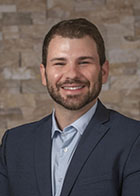
Joseph Douglass, MD
UMass Chan Medical School - PURCH
Hello everyone! My name is Joe and I am originally from Western Massachusetts. I grew up right next door to Baystate in Chicopee, MA before attending Assumption University for undergrad, where I studied Biology. From there, I had four gap years before medical school and spent the bulk of that time as a research technician at Brandeis University and BU School of Medicine, where I helped conduct a CRISPR project. I first became interested in emergency medicine during my gap years, when I spent time shadowing in an ED and also as a volunteer right here at Baystate. I then moved on to UMass Chan for medical school, where I was part of the PURCH Track, spending additional didactic time learning about the social determinants of health and having completed most of my clinical rotations at Baystate! At UMass and Baystate, I loved the pace, the ability to provide patient-facing care, the breadth of pathology, and the procedures of the ED. Though I am biased in this, I also feel that the best people are in EM, especially here at Baystate. Being from the area and having spent most of my clinical time at Baystate as a third year and as a Sub-I in the ED, choosing Baystate EM was an easy choice.
Academic interests include the intersection of climate change and healthcare. Additionally, I am currently interested in wilderness med, sports med, advocacy, and medical education — all of which I am excited to explore during residency.
Outside of the hospital, you can find me rooting on all of the Boston sports teams, trying to get out to play basketball, soccer, and golf, attempting a new recipe I found on YouTube, and being outdoors hiking or fishing!
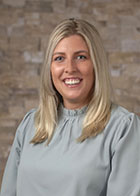
Jordan Eichelser, MD
St. George's University
Hey everyone! My name is Jordan. I was born and raised in Western Mass in a town called Pittsfield. I went to UMass Amherst for undergrad and received a Bachelor's in Biology. Once I graduated, I had the opportunity to work as a scribe at Berkshire Medical Center in the Emergency Department. I was there for 4 years (yes, you read that correctly… I was still trying to figure my life out) when I decided that I wanted to go to medical school. I went to St. George’s University, knowing all along that I was going to pursue emergency medicine after my experience as a scribe.
I chose Baystate for many reasons. Although I didn’t have the opportunity to rotate here during my fourth year, I was able to connect with current residents and alumni who were nothing but friendly and welcoming. When I worked alongside Baystate grads as a scribe, it was very apparent that they graduated feeling well-prepared and equipped to take on any challenge. Although my interview was on Zoom, I felt an instant sense of family and I could tell that resident wellness was a priority. I couldn’t ask for anything more in a program and I am so excited to be a part of the team!
Outside of medicine, I love spending time with my two dogs, doing all things outdoors, exploring new restaurants, and watching football (Go Dolphins)!

Frances Kimball Russo, DO
Edward via College of Osteopathic Medicine - Carolina's Campus
Hi Everyone! I grew up in Bridgton, Maine. Funny enough, after graduating High School I said I would “never take another science class.” While attending The University of Maine at Orono I unexpectedly took a job working as a Scribe in the Emergency Department in Bangor. Never say never. That ED is where I met the most wonderful mentors and officially began my path towards a calling in medicine. After completing my B.S. in Biology with a Pre-Med concentration, my husband and I moved to Virginia so I could pursue a Masters in Biomedical Science. That year I was accepted into VCOM. After finishing my Masters, I dragged my husband (willingly) to South Carolina where we have spent the last 4 years with our two outgoing crazy dogs.
I got the chance to rotate at Baystate during my 4th year auditions. I knew Baystate was the residency for me – it was just a feeling you get when you know you’re in the right place around the right people. I feel lucky!I’ll do almost anything at least once. I love to try new activities and travel new places. My hobbies range from reading to gem digging, mushroom foraging to playing piano, and baking bread to weight lifting. So excited to be joining the Baystate!!
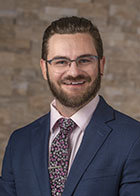
Calvin Knox, DO
Touro College of Osteopathic Medicine-New York
Hi everyone, I’m Calvin! I was born in South Africa and moved to the US when I was four. My family has lived in Oakland, New Jersey since then, but we went back to visit South Africa whenever we could (let me know if you ever plan on traveling there). I studied Exercise Science at Rutgers New Brunswick, where I also ran track. After undergrad, I went back to South Africa for six months to volunteer in different hospitals. It was there that I had my first real taste of EM and grew to love it. Following that experience, I worked as a scribe while waiting to attend medical school in New York.
I did an ultrasound rotation at Baystate during my 4th year and knew, after one week, that it was going to be my top choice. The culture, faculty, facility, and patient population were exactly what I was looking for when searching for a program. Plus, there is great food in the area, tons of outdoor activities, and plenty of places to grab a drink.
Outside of the hospital, I love doing just about anything and I’m always down to try something at least once. I enjoy hiking, golfing, kayaking, eating, playing board games, and general traveling. During residency, I would like to improve my cooking skills, learn Spanish, and get back into hobbies like skiing, biking, and rock climbing! One day I would like to open a coffee shop or small restaurant that hosts adoption days for local animal shelters.
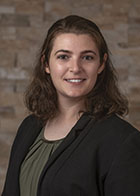
Lynn Leblanc, DO
Lincoln Memorial University DeBusk College of Osteopathic Medicine
Hey everyone, I’m Lynn! I grew up in Lebanon, NH, just two hours north of Baystate, though I have traveled all over New England. I moved to Vermont for undergrad at Castleton University (formerly Castleton State College) where I earned two degrees: one in Forensic Psychology and one in Chemistry. Following graduation, I worked full-time as Chief Medical Scribe in the ED in Rutland, VT for several years, where I first met and worked with a few of Baystate EM’s amazing alums! During this time, I also served in the U.S. Army Reserve for eight years with the 382ndMilitary Police Battalion, completing drill weekends at Westover Air Force Base in Chicopee, MA.
A couple of years after undergrad, I started working full-time as an EMT in Vermont until moving to Philadelphia, PA for graduate school, where I majored in Biomedical Sciences with a concentration in Forensic Medicine. Another move brought me to East Tennessee for medical school, where I knew from day one that I wanted to go into Emergency Medicine. During Fall of my 4th year, I had the privilege of rotating in the ED at Baystate and immediately felt at home. Everyone I had the pleasure to work with made me feel genuinely welcomed and like a valued member of the team. I knew that not only would Baystate’s high acuity and diverse, medically-complex patient population provide an excellent education, but their emphasis on resident wellness and camaraderie is what really stood out to me. I am very excited to join the Baystate family and to be moving back home to New England!
Outside of the hospital, you can find me curled up with a good book or movie, exploring new pubs and diners with friends, spending time with family in NH, hiking, running, powering through 1000-piece jigsaw puzzles in a single day, watching true crime documentaries, hitting up trivia nights at a local bar, or dog sitting for friends to get my puppy fix!
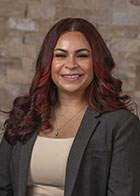
Stephanie Newsome, MD
St. George's University
Hey, everyone! I’m Steph. I grew up in Chicopee, MA, and graduated from Springfield College with a Bachelor’s degree in General Studies with a Minor in Psychology. After completing my undergraduate, I attended Elms College to obtain a Post-Baccalaureate in Pre-Medical Sciences. Throughout my undergraduate and post-graduate career, I worked at Baystate as a Unit Secretary, starting in the ICU. I loved working in the ICU because of all the great people and the fascinating cases we would get. It is what solidified my plan to become a doctor. I discovered Emergency Medicine during one of my clinical rotations in my third year. I instantly found my home. I loved everything about the ED; the residents I worked with were always willing to teach students. I knew it was the specialty for me.
Outside the Hospital, you can catch me reading a new book, binging a show, finding some great food, road-tripping, amateur interior designing, listening to True Crime shows, or doing a peloton workout. Tuende and Cody are the best! I have two fur babies. I have my 13-year-old cat Fuzzyman, who frequently has the zoomies still at 3 am, and I have my 7-year-old dog, Finnegan, who spends 90% of the day sleeping.
I chose Baystate because of the people! Everyone was so friendly and easy to talk to during my interviews. Even with interviews continuing to be virtual, I felt the family-like atmosphere through the screen. This added to the excellent training and diverse patient population, is everything I was looking for in a program. I am so excited to start this next chapter at Baystate!

Jennifer Nordbye, DO
A.T. Still University School of Osteopathic Medicine in Arizona
Hey there, I’m Jenny! I’m a lover of all things outdoors, traveling, food, and breweries. I grew up near Minneapolis (skol Vikings), so I’m a midwesterner at heart and you’ll often catch me putting Ranch dressing on anything edible. I moved away from the cold for a bit for medical school, first to Arizona and then to our Hawai’i campus for the past 3 years where I have soaked up all the sun I possibly can.
The first time I ever visited the northeast was for an away rotation in my 4th year of med school. I explored around while I was there, fell in love with New England and all there is to offer, and the rest is history! I met a mentor there who had trained at Baystate and had nothing but positive things to say about the culture and the program, which initially drew my interest. When I interviewed with the residents and faculty it felt so welcoming, even over Zoom, and it was such a fun-loving group of people I could definitely see myself spending the next several years of training with. Beyond being such a strong, diverse, high-volume EM training program, Baystate also showed a genuine appreciation for resident wellness that was hard to come by. I knew it was where I wanted to be!
Outside of the hospital, you can usually find me out exploring new places, checking out a local brewery or restaurant, taking a night in to catch up on my Netflix shows, hiking, or really doing anything outside. I love to travel, whether it’s a new country to see or a day trip to somewhere new nearby. I absolutely cannot wait to experience my first New England fall and to get back out on the ski slopes this winter for the first time in a few years!

Jacob Paul, DO
West Virginia School of Osteopathic Medicine
Hello!! I was born and raised in Kingston, NY, in the heart of the Hudson Valley. I went on to play baseball at Southern Connecticut State University while earning my B.S. in Exercise Science – Human Performance. After graduating, I worked for a few years as an exercise specialist and orthotic and prosthetic assistant. After this, I returned to school and earned my M.S. in Nutrition from Columbia University – Institute of Human Nutrition. I didn’t want to stop there, so I decided to further my education by attending medical school at West Virginia School of Osteopathic Medicine. In medical school, I served as the student government president and co-founded the lifestyle medicine club.
I decided to pursue Emergency Medicine because I fell in love with the teamwork atmosphere, the grassroots advocacy, and the fact that it feels like the rawest form of medicine, as you never know what you’ll get. I did not rotate at Baystate during my 4th year; however, I chose Baystate to come home! I missed the Northeast and living with family. Baystate checked every box for me and more, as it is somewhere I feel I can genuinely thrive personally and professionally. Baystate not only has high acuity and will provide tremendous educational experience but truly cares for their resident’s wellbeing.
Outside of medicine, you can find me spending time with my partner, our cat, and our baby boy. In my free time, I’m a big sports fan and movie buff. I Enjoy binging the latest shows, cooking, exploring local cuisine, and hitting the gym.

Kit Sitterley, DO
Burrell College of Osteopathic Medicine
Hi, I’m Kit! I grew up all over the United States, but I call Colorado and North Carolina home. After a long meandering career as an ice hockey player, taking me throughout North America and Europe, I graduated from the University of Massachusetts-Boston where I played collegiately and received my B.S. in Biology. After college, I spent a few years working in Orthopedics, Cardiology, traveling, and coaching on the side before attending medical school in Las Cruces, New Mexico.
My interest in Emergency Medicine is multifaceted, but was primarily born from being a hockey player and my experience with receiving and observing high-quality emergency care. After learning about Baystate, I knew I wanted to train there from the start – it was a gut feeling that simply never went away. Baystate has a great reputation and wonderful, supportive people. Their emphasis on resident well-being and a healthy work/life balance solidified it for me. To say I’m ecstatic about continuing my training at Baystate would be an understatement.
When I’m not in the ED you can usually find me trail running, fishing, golfing, alpine skiing or in search of a great IPA.
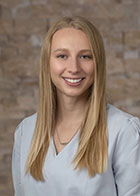
Rachel Truland, MD
Oakland University William Beaumont School of Medicine
I grew up in Troy, NY and completed my undergraduate degree at Hartwick College where I played soccer and majored in both biology and economics. The year after undergrad I worked for the Center for Craft Food and Beverage at Hartwick College getting laboratory experience in the craft beverage industry and was a teaching assistant on a trip to Portugal studying local food systems and fermentation science. During a second gap year I went back to healthcare and worked as an ED tech at Albany Medical Center where I was first exposed to the wonderful world of emergency medicine. I attended medical school at Oakland University William Beaumont School of Medicine in Michigan.
I knew I wanted to head towards the northeast for residency and Baystate soon became a clear first choice. Even in a virtual environment, I could feel the sense of community and value for their residents. I was looking for a department with high volume, acuity, and diverse patient population and am confident Baystate will provide all of that and more.
Outside of work, I enjoy spending time with my significant other, Iain, and our dog Reggie, skiing, hiking and traveling to new places. We are excited to explore our new home of Western MA!
Chief Residents' Message
We See Lots of Patients and Lots of Diagnoses
We work in one of the busiest emergency departments in all of Massachusetts with >115,000 visits per year.
Our ED has 94 beds and provides a constant supply of sick and critically ill patients. In between evaluating everyday chest pain, abdominal pain and sprained ankles, we care for Level-1 Trauma patients, acute stroke patients, and STEMIs.
The variety and volume of patients that we see on a daily basis is unparalleled.
This is an Amazing Place to Learn and Teach
In addition to direct patient care, we serve as a clinical site for rotating medical students and this allows the residents to hone our teaching skills.
We also participate in simulation exercises through Baystate’s Simulation Center to allow us to practice caring for uncommon illnesses and injuries.
Lastly, Baystate has a variety of fellowship programs, including Ultrasound, Administration, Research, Pediatric Emergency Medicine and Wilderness Medicine. Collectively, all of these things provide an amazing place to train and to learn.
Now, Let’s Talk About the People
Our attendings are amazing, and their experience ranges from new graduates fresh out of fellowship to veteran attendings who have been practicing Emergency Medicine for >25 years. Each of our attendings brings a unique perspective to our shifts and their collective desire to teach is inspiring. They encourage resident autonomy while also ensuring that we have enough support to do our jobs safely and effectively while also continuing to learn.
Lastly, and most importantly, our co-residents are the best. We couldn’t ask for better colleagues and friends. When looking at residencies, you want to find a place where you fit in and where you feel supported. This is the place.
We're Excited About Our Plans for this Year
As chief residents for 2024-2025, we want to encourage you to come check us out and see all that Baystate has to offer. We’re proud of our program and can’t wait to make it even better.
Recent Graduates
In the last 5 years, our residents have started off their post-graduate lives all across the U.S. from Maine to California, from Oregon to Florida, and 13 states in between.
Many choose to stay right here in New England.
We are proud to say that 100% of our graduates who sought specialty training were accepted into fellowship programs. Overall, 33% of our graduates went on to fellowships.
We invite you to learn more about our recent graduates.
2025
Oscar Barnes-Valldejuly, MD
Medical School: University of Puerto Rico School of Medicine
Gabriella (Gabby) Bilyeu, DO
Medical School: Pacific Northwest University of Health Sciences College of Osteopathic Medicine
Geoffrey (Will) Fisher, DO
Medical School: University of New England College of Osteopathic Medicine
Meghan Harrington, MD
Medical School: UMass Chan Medical School
Grace Klanderud, MD
Medical School: Creighton University School of Medicine
James Kramer, DO
Medical School: Pacific Northwest University of Health Sciences College of Osteopathic Medicine
Jinjoo Lee, DO
Medical School: Liberty University College of Osteopathic Medicine
Zoe Lombard, DO
Medical School: Edward Via College of Osteopathic Medicine-Carolinas Campus
Jacob (Jake) Luecke, MD
Medical School: University of Connecticut School of Medicine
Brendan Mcfall, DO
Medical School: Alabama College of Osteopathic Medicine
Sebastian Orman, MD
Medical School: Georgetown University School of Medicine
Matthew (Matt) Senno, DO
Medical School: University of New England College of Osteopathic Medicine
Syara Slaughter, DO
Medical School: Philadelphia College of Osteopathic Medicine
Andrew Tan, DO
Medical School: New York Institute of Technology College of Osteopathic Medicine
Ashley Tracy, DO
Medical School: University of New England College of Osteopathic Medicine
Jenna Wells, MD
University of Vermont College of Medicine
2024
Collen Bannigan, DO
Medical School: Edward Via College of Osteopathic Medicine -Virginia Campus, Blacksburg, VA
Post Graduate Position: Sports Medicine Fellow at Lewis-Gale-VCOM Virginia Tech in Blacksburg, VA
Dean Cataldo, DO
Medical School: University of New England College of Osteopathic Medicine, Biddeford, ME
Post Graduate Position: Attending Physician at NMRTC Portsmouth in Portsmouth, VA
Colton Conrad, MD
Medical School: University of Massachusetts Medical School, Worcester, MA
Post Graduate Position: EMS Fellow at Baystate Medical Center in Springfield, MA
Laura Director, MD
Medical School: University of Vermont College of Medicine, Burlington, VT
Julianne Earle, DO
Medical School: New York Institute of Technology College of Osteopathic Medicine Glen Head, NY
Post Graduate Position: Medical Education Fellow at Baystate Medical Center in Springfield, MA
Teana Gravel, DO
Medical School: New York Institute of Technology College of Osteopathic Medicine, Glen Head, NY
Georgina Koutouzis, DO
Medical School: Edward Via College of Osteopathic Medicine -Virginia Campus, Blacksburg, VA
Post Graduate Position: Attending Physician at Backus Hospital in Norwich, CT
Kelsie Mitchell, DO
Medical School: University of New England College of Osteopathic Medicine, Biddeford, ME
Post Graduate Position: Attending Physician at Berkshire Medical Center in Pittsfield, MA
Alyssa Muchisky, MD
Medical School: Geisinger Commonwealth School of Medicine, Scranton, PA
Post Graduate Position: Attending Physician at Geisinger Community Medical Center in Scranton, PA
Caleb Noone, MD
Medical School: University of Massachusetts Medical School, Worcester, MA
Post Graduate Position: Attending Physician at Cooley Dickinson Hospital in Northampton, MA
Emily Norman, MD
Medical School: Geisel School of Medicine at Dartmouth, Hanover, NH
Post Graduate Position: Attending Physician at Baystate Franklin in Greenfield, MA
Sahil Pandya, MD
Medical School: Geisinger Commonwealth School of Medicine, Scranton, PA
Post Graduate Position: Attending Physician at Geisinger Community Medical Center in Scranton, PA
Michael Penna, DO
Medical School: Lake Erie College of Osteopathic Medicine, Erie, PA
Post Graduate Position: Attending Physician at Wake Forest Emergency Providers in Winston Salem, NC
Ana Maleesa Santos, MD
Medical School: University of Massachusetts Medical School, Worcester, MA
Post Graduate Position: Attending Physician at St. Peter's Hospital in Albany, NY
Emily Schaffer, DO
Medical School: University of New England College of Osteopathic Medicine, Biddeford, ME
Post Graduate Position: Attending Physician at Baystate Wing in Palmer, MA
Bessie Young, MD
Medical School: University of California San Francisco School of Medicine, San Francisco, CA
Post Graduate Position: Attending Physician at Berkshire Medical Center in Pittsfield, MA
2023
Danielle Aston, DO
Medical School: New York Institute of Technology College of Osteopathic Medicine
Post-Graduate Position: Emergency Medicine Ultrasound Fellowship, UMass Chan-Baystate, Springfield, MA
Stephanie Ayala, DO
Medical School: Burrell College of Osteopathic Medicine
Cassidy Carpenter, DO
Medical School: University of New England College of Osteopathic Medicine
Post-Graduate Position: Emergency Medicine Education Fellowship, UMass Chan-Baystate, Springfield, MA
Alex Estrella, MD
Medical School: New York University School of Medicine
Post-Graduate Position: Critical Care Fellowship, Cooper University Hospital, Camden, NJ
Catherine Faulkner, MD
Medical School: Geisinger Commonwealth School of Medicine
Post-Graduate Position: Emergency Medicine Physician, UH Portage Medical Center, Ravenna, OH
Erica Jessen, MD
Medical School: Zucker School of Medicine at Hofstra
Post-Graduate Position: Emergency Medicine Physician, Berkshire Medical Center, Pittsfield, MA
Brendon Kinsley, MD
Medical School: University of Vermont Larner College of Medicine
Post-Graduate Position: Emergency Medicine Wilderness Fellowship, UMass Chan-Baystate, Springfield, MA
Mackenzie Laporte, MD
Medical School: Albany Medical College
Post-Graduate Position: Emergency Medicine Education Fellowship, UMass Chan-Baystate, Springfield, MA
Caroline Lloyd, DO
Medical School: Philadelphia College of Osteopathic Medicine
Post-Graduate Position: Emergency Medicine International Disaster Fellowship, University of Connecticut, Farmington, CT
Sarah McHugh, MD
Medical School: University of Rochester School of Medicine
Post-Graduate Position: Pediatric Emergency Medicine Fellowship, Connecticut Children's Medical Center, Hartford, CT
Steven Moss, DO
Medical School: University of New England College of Osteopathic Medicine
Post-Graduate Position: Sports Medicine Fellowship, North Shore University Hospital, Manhasset, NY
Jessica Patel, DO
Medical School: University of New England College of Osteopathic Medicine
Post-Graduate Position: Global Health Fellowship, Columbia University, New York, NY
Joseph Stevens, DO
Medical School: University of Pikesville Kentucky College of Osteopathic Medicine
Post-Graduate Position: Emergency Medicine Physician, Tristar Greenview Regional Hospital, Bowling Green, KY
Luca Tomasi, MD
Medical School: Tufts University School of Medicine
Post-Graduate Position: Emergency Medicine Ultrasound Fellowship, UMass Chan-Baystate, Springfield, MA
Michael Zampi, MD
Medical School: Albany Medical College
Post-Graduate Position: Emergency Medicine Ultrasound Fellowship, UMass Chan-Baystate, Springfield, MA
Meghann Zapcic-Desrochers, MD
Medical School: Lewis Katz School of Medicine at Temple University
Post-Graduate Position: Emergency Medical Services Fellowship, Brown University, Providence, RI
2022
Kristen Dalton, MD
Medical School: University of Vermont Larner College of Medicine
Post-Graduate Position: Emergency Medicine Wellness Fellowship, UMass Chan-Baystate, Springfield, MA
Caitlin Farrell, DO
Medical School: University of New England College of Osteopathic Medicine
Post-Graduate Position: Health Equity Fellowship, Boston Medical Center, Boston, MA
Mathew Goebel, MD
Medical School: UC San Diego School of Medicine
Post-Graduate Position: Emergency Medicine Research Fellowship, UMass Chan-Baystate, Springfield, MA
Michelle Holton, DO
Medical School: Nova Southeastern University College of Osteopathic Medicine
Post-Graduate Position: Emergency Medicine Physician, Roger Williams Medical Center, Providence, RI
Joseph Lahey, MD
Medical School: University of Vermont Larner College of Medicine
Post-Graduate Position: Emergency Medicine Physician, Northwestern Medical Center, St. Albans, VT
Cody Laverdiere, DO
Medical School: Western University of Health Sciences College of Osteopathic Medicine of the Pacific, Lebanon Campus
Post-Graduate Position: Emergency Medicine Physician, Kootenai Health, Couer d'Alene, ID
Bryanne MacDonald, MD<
Medical School: University of Massachusetts Medical School
Post-Graduate Position: Emergency Medicine Education Fellowship, UMass Chan-Baystate, Springfield, MA
Daniel Madden, MD, MPH
Medical School: University of Connecticut School of Medicine
Post-Graduate Position: Emergency Medicine Wilderness Fellowship, UMass Chan-Baystate, Springfield, MA
Dylan Maziur, DO
Medical School: Alabama College of Osteopathic Medicine
Post-Graduate Position: Emergency Medicine Physician, West Florida Hospital, Pensacola, FL
Masood Mohammed, DO
Medical School: Nova Southeastern University College of Osteopathic Medicine
Post-Graduate Position: Emergency Medicine Education Fellowship, Christiana Hospital, Wilmington, DE
Eleanor Ragone, DO
Medical School: Lake Erie College of Osteopathic Medicine, Erie
Post-Graduate Position: Emergency Medicine Physician, Fairview Hospital, Great Barrington, MA
Natalie Strokes, DO
Medical School: A.T. Still University School of Osteopathic Medicine in Arizona
Post-Graduate Position: Emergency Medicine Health Equity Fellowship, UMass Chan-Baystate, Springfield, MA
Sean Tiret, MD
Medical School: Keck School of Medicine of the University of Southern California
Post-Graduate Position: Emergency Medicine Physician, MarinHealth Medical Center, Greenbrae, CA
Anna Tyson, MD
Medical School: University of Alabama School of Medicine
Post-Graduate Position: Emergency Medicine Ultrasound Fellowship, UMass Chan-Baystate, Springfield, MA
Jeff Wisniowski, DO
Medical School: University of New England College of Osteopathic Medicine
Post-Graduate Position: Emergency Medicine Physician, Roger Williams Medical Center, Providence, RI
Adrianne Wurzl, DO
Medical School: University of New England College of Osteopathic Medicine
Post-Graduate Position: Emergency Medicine Wilderness Fellowship, UMass Chan-Baystate, Springfield, MA
2021
Jessica Armstrong, MD
Medical School: University of Connecticut School of Medicine
Post-graduate Position: Attending, Berkshire Medical Center, Pittsfield, MA
Samuel Broder, DO
Medical School: University of New England School of Osteopathic Medicine
Post-graduate Position: Attending, Baystate Franklin, Greenfield, MA
Ofelia Cabrera, DO
Medical School: Edward Via College of Osteopathic Medicine, Carolina Campus
Post-graduate Position: West Florida Hospital, Pensacola, FL
Stephen Digiacomo, MD
Medical School: USF Health Morsani College of Medicine
Post-graduate Position: Fellow, EM Clinical Ultrasound Fellowship, UMMS-Baystate, Springfield, MA
Erik Doty, DO
Medical School: University of New England College of Osteopathic Medicine
Post-graduate Position: Attending, Concord Hospital, Concord, NH
Kristen Dowdy, DO
Medical School: Arizona College of Osteopathic Medicine
Post-graduate Position: Attending, Joint Base Andrews, Maryland
Allison Earon, MD
Medical School: University of Massachusetts Medical School
Post-graduate Position: Attending, Baystate Franklin, Greenfield, MA
Jonathan Gammel, MD
Medical School: University of Massachusetts Medical School
Post-graduate Position: Fellow, EM Education Fellowship, UMMS-Baystate, Springfield, MA
Chelsea Green, DO
Medical School: Rocky Vista University College of Osteopathic Medicine
Post-graduate Position: Fellow: EM Education Fellowship, UMMS-Baystate, Springfield, MA
Ashley Kunz, MD
Medical School: University of Nebraska College of Medicine
Post-graduate Position: Attending, Baystate Medical Center, Springfield, MA
Kent McCann, MD
Medical School: University of Massachusetts Medical School
Post-graduate Position: Fellow, Palliative Care Fellowship, St. Luke’s, Bethlehem, PA
Matthew Shapiro, DO
Medical School: University of New England College of Osteopathic Medicine
Post-graduate Position: Fellow, EMS Fellowship, Yale University School of Medicine, New Haven, CT
Will Spencer, DO
Medical School: University of New England College of Osteopathic Medicine
Post-graduate Position: Fellow, EM Clinical Ultrasound, UMMS-Baystate, Springfield, MA
Brian Thompson, DO
Medical School: University of New England College of Osteopathic Medicine
Post-graduate Position: Fellow, EM Clinical Ultrasound, UMMS-Baystate, Springfield, MA
Back to Top

